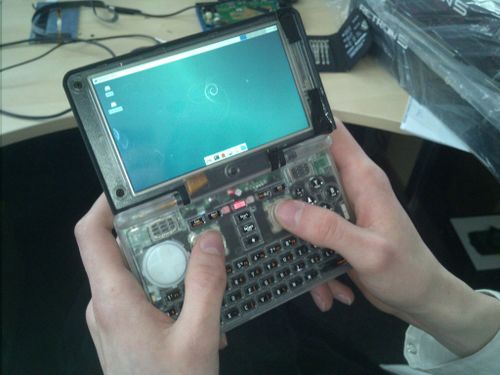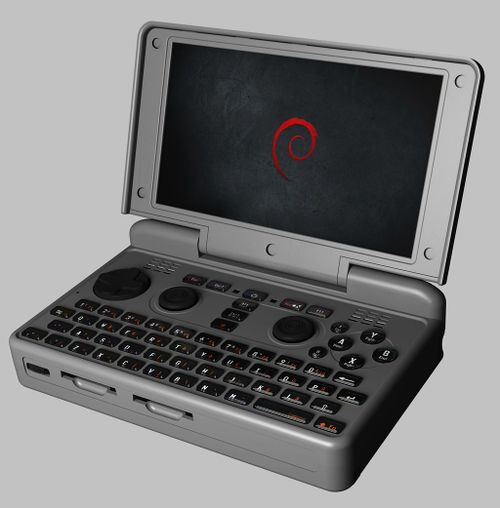No edit summary |
(→Storage: Add notes about the USB ports.) |
||
| (13 intermediate revisions by 5 users not shown) | |||
| Line 1: | Line 1: | ||
[[Image:Pyra_Prototype.jpeg | right | 500px | thumb | First assembled Prototype, Part Mould based Case Parts and part 3d Printed Case Parts]] | [[Image:Pyra_Prototype.jpeg | right | 500px | thumb | First assembled Prototype, Part Mould based Case Parts and part 3d Printed Case Parts]] | ||
[[Image:Pyra.jpeg | right | 500px | thumb | Rendering]] | [[Image:Pyra.jpeg | right | 500px | thumb | Rendering]] | ||
The Pyra is a perfect pocket device for everyday computing, gaming, emulation or hacking. It is a unique combination of a gaming handheld and a mini-laptop (approximately the size of the | The Pyra is a perfect pocket device for everyday computing, gaming, emulation or hacking. It is a unique combination of a gaming handheld and a mini-laptop (approximately the size of the original Gameboy), running plain Debian Linux as OS. It is the successor of the [[OpenPandora]]. | ||
== | == Specifications == | ||
=== Case === | |||
Main article: [[Case]] | |||
* Polycarbonate case, 140 x 74 x 29 mm | |||
=== Input Devices === | === Input Devices === | ||
* Gaming controls (DPad, 4 shoulder buttons, 6 face buttons) | * Gaming controls (DPad, 4 shoulder buttons, 6 face buttons) | ||
| Line 14: | Line 18: | ||
=== Internals === | === Internals === | ||
* 6000mAh [[Battery]] | * 6000mAh [[Battery]] | ||
* 720p 5" LCD (Interchangeable in the Future) | * 720p 5" LCD [[Display]] (Interchangeable in the Future) | ||
* Vibration motor | * Vibration motor | ||
* Various sensors (accelerometer, gyro-sensor, etc.) | * Various [[Sensors|sensors]] (accelerometer, gyro-sensor, etc.) | ||
* | * Three PCBs; | ||
:* | :* An interchangeable [[CPU-Board]]: | ||
:* Texas Instruments [[OMAP 5]] SoC: | ::* 2 or 4GB [[RAM]] | ||
::* 2x ARM Cortex-A15 @ 1.5Ghz with NEON SIMD | ::* Texas Instruments [[OMAP 5]] SoC: | ||
::* 2x ARM Cortex-M4 | :::* 2x ARM Cortex-A15 @ 1.5Ghz with NEON SIMD | ||
::* PowerVR™ SGX544-MP2 (see [[GPU]]) | :::* 2x ARM Cortex-M4 | ||
::* Vivante GC320 2D Accelerator | :::* PowerVR™ SGX544-MP2 (see [[GPU]]) | ||
:::* Vivante GC320 2D Accelerator | |||
::* 32GB of eMMC flash for the preinstalled OS | |||
:* A [[Mainboard]] where all [[Peripherals|peripherals]] connect | |||
:* and a [[Displayboard]] which interfaces the [[Display|display]] and the touchscreen to the hinge cable (which connects the case lid components to the [[Mainboard]]) | |||
=== Connectivity === | === Connectivity === | ||
* Integrated [[WiFi|Wi-Fi]] 802.11a/b/g/n and [[Bluetooth]] 4. | * Integrated [[WiFi|Wi-Fi]] 4 (802.11a/b/g/n) and [[Bluetooth]] 4.1 | ||
* Optional 3G/4G/UMTS [[Modem]] and [[GPS]] | * Optional 3G/4G/UMTS [[Modem]] and [[GPS]] | ||
* Headset-Port | * [[Audio|Headset-Port]] | ||
* 1x HDMI Video Out | * 1x HDMI Video Out | ||
* 2x Full-size USB Host (one can be used as eSATA with a small [[ | * [[USB]] ports, permitting many [[Peripherals]] to be connected: | ||
* 1x Micro USB 3.0 | :* 2x Full-size USB 2.0 Host (one can be used as eSATA with a small [[ESATA_Adapter|Adapter]]) | ||
* 1x Micro USB (Debug and Charging) | :* 1x Micro USB 3.0 OTG | ||
:* 1x Micro USB (Debug and Charging) | |||
* Status [[LEDs]] | |||
=== [[Storage]] | === Storage === | ||
* Internal eMMC | Main article: [[Storage]] | ||
* 1x Internal MicroSDHC | * 32GB Internal eMMC | ||
* | * 1x Internal MicroSDHC slot | ||
* 2x SDXC card slot (External, below the keyboard) | |||
* Optional SATA adaptor which connects to the blue USB 2.0 port and allows the connection of a SATA device such as an SSD (although another solution is needed to provide sufficient power to the drive) | |||
* As much USB storage as you can stuff in it | |||
Latest revision as of 22:43, 9 November 2020


The Pyra is a perfect pocket device for everyday computing, gaming, emulation or hacking. It is a unique combination of a gaming handheld and a mini-laptop (approximately the size of the original Gameboy), running plain Debian Linux as OS. It is the successor of the OpenPandora.
Specifications
Case
Main article: Case
- Polycarbonate case, 140 x 74 x 29 mm
Input Devices
- Gaming controls (DPad, 4 shoulder buttons, 6 face buttons)
- Two accurate analog controls (Nubs) with push-button
- QWERTY Keyboard with backlight
- Touchscreen
- Analog volume wheel
Internals
- 6000mAh Battery
- 720p 5" LCD Display (Interchangeable in the Future)
- Vibration motor
- Various sensors (accelerometer, gyro-sensor, etc.)
- Three PCBs;
- An interchangeable CPU-Board:
-
- 2x ARM Cortex-A15 @ 1.5Ghz with NEON SIMD
- 2x ARM Cortex-M4
- PowerVR™ SGX544-MP2 (see GPU)
- Vivante GC320 2D Accelerator
- 32GB of eMMC flash for the preinstalled OS
- A Mainboard where all peripherals connect
- and a Displayboard which interfaces the display and the touchscreen to the hinge cable (which connects the case lid components to the Mainboard)
Connectivity
- Integrated Wi-Fi 4 (802.11a/b/g/n) and Bluetooth 4.1
- Optional 3G/4G/UMTS Modem and GPS
- Headset-Port
- 1x HDMI Video Out
- USB ports, permitting many Peripherals to be connected:
- 2x Full-size USB 2.0 Host (one can be used as eSATA with a small Adapter)
- 1x Micro USB 3.0 OTG
- 1x Micro USB (Debug and Charging)
- Status LEDs
Storage
Main article: Storage
- 32GB Internal eMMC
- 1x Internal MicroSDHC slot
- 2x SDXC card slot (External, below the keyboard)
- Optional SATA adaptor which connects to the blue USB 2.0 port and allows the connection of a SATA device such as an SSD (although another solution is needed to provide sufficient power to the drive)
- As much USB storage as you can stuff in it


